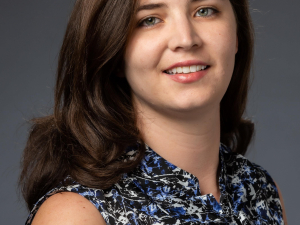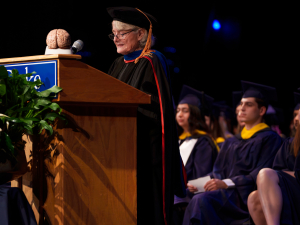P&N Person of the Week: Terrie Moffitt
Duke Psychology and Neuroscience Professor Terrie Moffitt was recently elected to the National Academy of Medicine, a leading organization providing advice on health, science and technology. P&N held a reception in her honor on Friday, 10/26.
A Colorful Mind
The interior of the Grey Building, where the Moffitt Lab resides, is anything but grey. Duke Psychology and Neuroscience Professor Terrie Moffitt, donning vibrant purple frames and earrings that dangled little crystal drops, gave me a tour.
Large windows, high ceilings, white with red accents—it all felt modern with a dash of retro. Lining the walls were striking portrait photographs from Burma, Namibia, Zimbabwe, Bolivia, Zambia, Swaziland—all shot by Moffitt herself.
Moffitt has been to 60 countries, including all the continents plus the North and South Poles. Some were for her work; she has collaborators in London, a longitudinal study in New Zealand and endless conferences around the world. The rest of those countries were “just for fun” with her husband and colleague, Avshalom Caspi, who runs the lab with her.
“We have this map that’s color coded by disease: blue being the least and red being the worst,” Moffitt said. “So we decided, let’s go to the red ones first while we’re still young and our immune systems can handle it.”
***
Her research can seem as diverse and scattered as her adventures. One look at her website and you’ll see that she studies everything from genes and their interactions with the environment, to aging, to how the neighborhood where a child grows up affects their future health and to the effects of cannabis.
The overarching theme of all of her projects: how things that happen to humans in early life influence later life in terms of mental health, physical health and aging.
As one of the most highly cited researchers at Duke and a recognized Thomson Reuters Highly Cited Researcher, Moffitt began her academic career as an English major at University of North Carolina at Chapel Hill. She realized her writing wasn’t that strong, and she was having more fun in her psychology classes where she got to observe children’s behaviors hands-on.
After college, she worked as an animal lab technician in the Research Triangle Park. Then, she went on to obtain a masters in experimental animal behavior and a doctorate in clinical psychology at University of Southern California, where she studied the effects of proximity to microwave ovens—a new technology at the time—on animals. Before coming to Duke, Moffitt was a professor at University of Wisconsin at Madison for over 20 years.
When it came to deciding whether she should come to Duke, Moffitt had a checklist: a world-class psychology department, an established exchange with a medical school, a good climate, strong neuroscience and really smart undergrads.
“Teaching [Duke students] is effortless,” Moffitt said. “The students practically teach themselves.”
She said that her biggest privilege as a mentor is interacting with budding researchers and bright students.
“They keep me young and new,” she said. “Being surrounding by 60-year-olds would be boring in the extreme.”
Postdoctoral fellow Amber Beckley described Moffitt as being very involved.
“She’s really great about caring for you as a person, giving advice on career decisions, how to balance things in your life,” Beckley said. “She works a lot, but finds time to take care of her family and enjoy her life.”
Ph.D. student Aaron Reuben said that the camaraderie in the lab has made collaborating easy and pleasant. Farm parties at Moffitt’s 230-acre farm and high tea are some of the events that the Moffitt Lab hosts. Pumpkins cluster a table in the lobby of the lab, awaiting the upcoming pumpkin-carving get-together.
“[If I wasn’t a psychologist], I would open a flower shop and put together little flower arrangements,” Moffitt said. “But that’s more just a joke.”
In addition to being a psychologist, she’s not only a world adventurer but also a film creator, actress, writer and artist, and she even has a patent. Her patent is an invention on “a method for assessing behavioral predisposition.” It evaluates tendencies for a violent or antisocial—that is, sociopathic—person who has experienced childhood maltreatment to have a mental disorder phenotype by determining whether the person carries a certain allele.
When it comes to research, it’s not just about presenting at scientific conferences. She takes the time to also engage the public in her science through museum exhibits, blogs, films and articles.
“Predict My Future: The Science of Us” documents Moffitt’s longitudinal study gathering data periodically from more than 1,000 people in Dunedin, New Zealand, following their lives from birth to the present. Those 1,000-plus people are the most scientifically studied cohort in the world.
Moffitt partnered with an artist to open a museum instillation: a three-part video series called “Nature’s Great Experiment” on her Environmental Risk Longitudinal Twin Study in London. She did the voiceover for one of the three films. Her acting career goes back to 1973 when Moffitt acted a speaking part in a feature film about NASCAR.
***
The color compositions in Moffitt’s travel portraits show balance, contrast, emphasis, movement, pattern, rhythm, variety and unity—and she paints her life with the same brush.
“I always carry a fun little polaroid with me,” Moffitt said. “I ask for permission for a photo and give them a photo to keep.”
“Any adventure is a good adventure [with her],” Caspi said. “Well, she didn’t enjoy the high mountains in Bolivia because she said, ‘it’s important to have oxygen on a holiday.’”
Caspi described their research partnership as a labor of love. They both met at a conference at Washington University of St. Louis in their 20s.
I asked Caspi about the multitude of Moffitt’s colorful glasses.
“Not as many as earrings,” he said. “She has a whole collection of frames, usually cycling four at a time.”
Recently, another color was added into the mix on her palette: an election to the National Academy of Medicine, where she will advise government on how they can best use science to inform the future of health and health care.
According to the NAM’s website, she was elected for her “path-breaking contributions to our understanding of human development.” These contributions included “her seminal theory of the development of antisocial behavior, which has had wide-ranging influence on clinical diagnosis of childhood conduct disorders, the early-years intervention movement and two Supreme Court decisions.”
The election process began with a confidential nomination by two NAM members who were familiar with Moffitt’s work. The members then vetted her for distinguished professional achievement in medicine and continued involvement with the issues of health care, prevention of disease and education.
“Election to the National Academy of Medicine is considered one of the highest honors in the fields of health and medicine and recognizes individuals who have demonstrated outstanding professional achievement and commitment to service,” the NAM website read.
During the Annual Meeting in Washington, D.C. on Oct. 15, the NAM announced their 85 new members, including Moffitt, who will commit to volunteer their service in National Academies activities.
“They sent a paper letter with an actual stamp,” Moffitt said.
And if that wasn’t enough news in her life, Moffitt also has a new project that’s using neuroimaging to understand how an individual’s social life alters their brain.
“Now I’m scrambling to learn about neuroscience,” Moffitt said.




